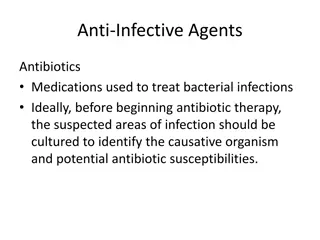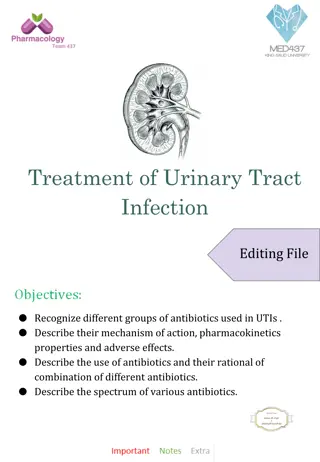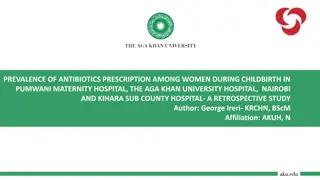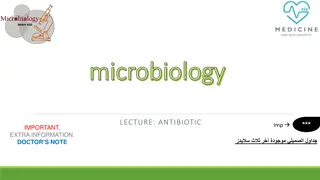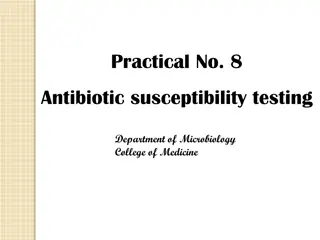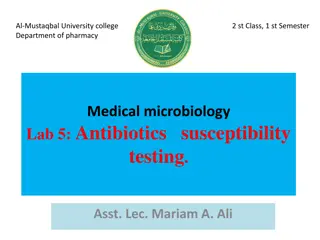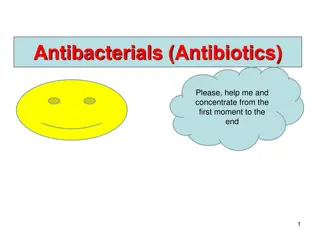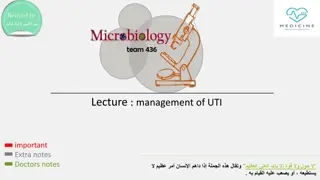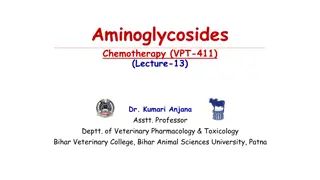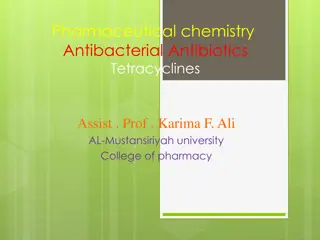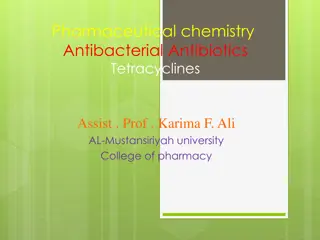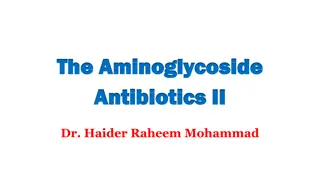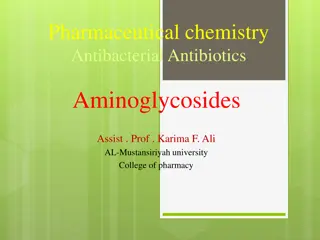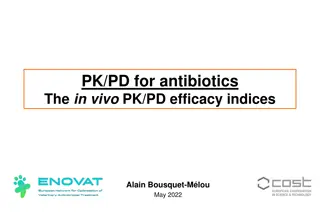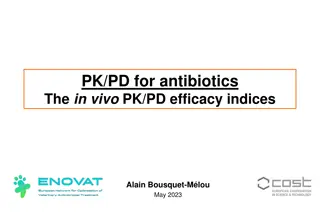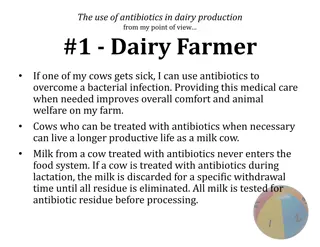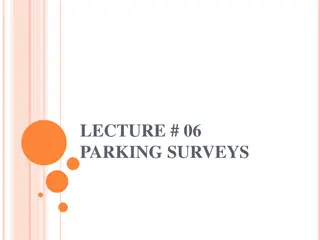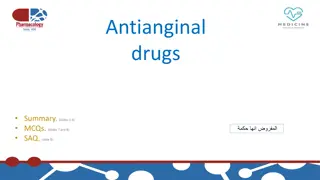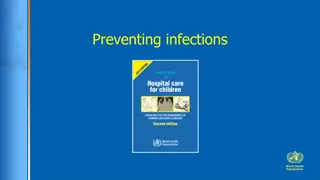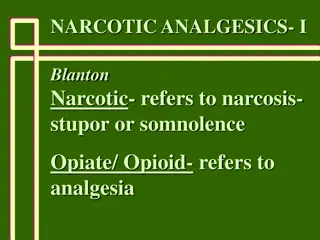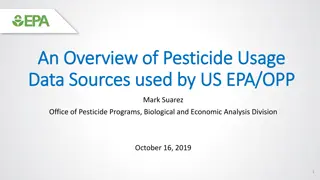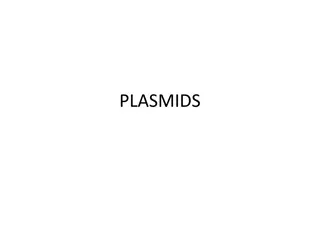Understanding Antibiotics: Types, Mechanisms, and Usage
Antibiotics, or antibacterials, are essential antimicrobial drugs used to treat and prevent bacterial infections. They work by either killing or inhibiting the growth of bacteria. They are classified based on factors like mechanism of action, chemical structure, and spectrum of activity. Factors influencing antibiotic choice include infection severity, kidney and liver function, allergies, and pregnancy. Side effects can occur, so monitoring and proper usage are crucial.
Download Presentation

Please find below an Image/Link to download the presentation.
The content on the website is provided AS IS for your information and personal use only. It may not be sold, licensed, or shared on other websites without obtaining consent from the author. Download presentation by click this link. If you encounter any issues during the download, it is possible that the publisher has removed the file from their server.
E N D
Presentation Transcript
Lecture Five Antibiotics, also called antibacterials, are a type of antimicrobial drug used in the treatment and prevention of bacterial infections. They may either kill or inhibit the growth of bacteria. Types of Antibiotics:- 1-Natural antibiotics :-An antibiotic is any substance that produced by a microorganism, (i.e. bacteria or fungi ), that it sends outside its cell to harm or kill another microorganism. 2- Synthetic antibiotics (Antimicrobial agent) :-Are antibiotics able to synthesize as chemical substances in the laboratory to be use against harmful microorganisms in our environment. Antibiotics are used to treat infections caused by germs (bacteria and certain parasites). A parasite is a type of germ that needs to live on or in another living being (host). Antibiotics are sometimes called antibacterials or antimicrobials. The effectiveness of individual antibiotics varies with the location of the infection and the ability of the antibiotic to reach this site. *Antibiotics are not effective against viruses (for example, the common cold or flu), or fungi (for example, thrush in the mouth), or fungal infections of the skin. Most common infections are caused by viruses. If you have a mild bacterial infection, the immune system can clear most of the bacterial infections. For example, antibiotics usually do little to speed up recovery from bronchitis, or most ear, nose, and throat infections that are caused by bacteria. So, do not be surprised if a doctor does not recommend an antibiotic for conditions caused by viruses or non-bacterial infections, or even for a mild bacterial infection. 1
Antibiotics classifications:- Antibiotics can be taken by mouth as liquids, tablets, or capsules, or by injection, creams, ointments, to apply to the skin to treat certain skin infections. Antibiotics are commonly classified based on their:- 1-mechanism of action:- Some antibiotics attack the cell membrane and others inhibit the synthesis of nucleic acids and proteins. 2-chemical structure:- Depend on the effect of chemical structure for example Beta-Lactam ring (figure-1: Beta-Lactam is a ring in the structure of the Penicillin). Beta-Lactam ring figure-1: Beta-Lactam ring present in Penicillin structure. 3- spectrum of activity:- They target a range of bacteria named as gram positive (+ve) bacteria, and gram negative (- ve) bacteria . -If pathogen is not identified (bacteria gram positive (+ve) bacteria, and gram negative (- ve) bacteria). For super infection Amoxicillin, Streptomycin are used. How do antibiotics work? 1- Some antibiotics work by killing germs (bacteria or the parasite). This is often done by interfering with the structure of the cell wall of the bacterium or parasite. 2-Some work by stopping bacteria or the parasite from multiplying. 2
There are many factors that influence the choice of an antibiotic to beused. These include:- How severe the infection is. How well your kidneys and liver are working. Dosing amount. Other medications you may be taking. A history of having an allergy to a certain type of antibiotic. If you are pregnant or breast-feeding. Even if you are pregnant or breast-feeding there are a number of antibiotics that are thought to be safe to take. Doctors sometimes choose certain antibiotics if they know there is a certain pattern of infection in your community. Side effect of Antibiotic:- Period of time a patient must take antibiotics and drugs depending on the type of the disease. For example a person suffering from dizziness, cough, runny nose will probably only take a few days to take your medicine. However, for patients with chronic diseases such as diabetes, tuberculosis, will certainly require a long period of time in which he must regularly taking antibiotics and drugs. The use of antibiotics in the long term need to watch out, because it can cause symptoms of organ function disorder more serious, for example, disturbances in liver function, liver damage, a decrease in the number of white blood cell production, disruption of brain function, cardiac dysfunction, coma, swelling , and irritation of the large intestine. Similarly, the side effects of antibiotics are also quite influence the health of the body and can even cause death. Avoid taking drugs in excess, please follow the instructions or doses that have been given by your doctor. 3
The Side Effect Of Antibiotics And Its Dangers On Human Body:- Here are some of the side effects & dangers that can be caused by taking antibiotics and drugs in the long term: 1-Digestive disorders: It is most commonly caused by drugs in the long term are nausea, diarrhea, cramping and abdominal pain. 2-Allergies cause: Most people will experience these symptoms, where there is itching. Sometimes the spots appear on the skin. 3-Cardiac dysfunction. Symptoms are characterized by feeling heart palpitations. 4-Headache. 5-Decreased appetite, 6-Disrupt the immune system. The use of antibiotics in the long term can eradicate and prevent the growth of microorganisms. This will result in the body lacks vitamins, especially vitamin K and vitamin B12. 8-Jaundice. 9-The kidney problems. 10-Disorders of the nerves, for example a person will feel tingling. The emergence of resistance of bacteria to antibiotics Its a common phenomenon often reflects a processes that take place during antibiotic therapy. The antibiotic treatment may select for bacterial strains with physiologically or genetically enhanced capacity to survive high doses of antibiotics (figure-2). For example, Antibiotics such as penicillin and erythromycin, which used to have a high efficacy against many bacterial species and strains, have become less effective, due to the increased resistance of many bacterial strains (figure-3). 4
Antibacterial-resistant strains and species, sometimes referred to as "superbugs", now contribute to the emergence of diseases that were for a while well controlled. For example, emergent bacterial strains causing tuberculosis (TB) that are resistant to previously effective antibacterial treatments pose many therapeutic challenges. Every year, nearly half a million new cases of multidrug- resistant tuberculosis (MDR-TB) are estimated to occur worldwide. For example, NDM-1 enzyme(New Delhi Metallo-beta-lactamase- 1enzyme) is a newly identified enzyme conveying bacterial resistance to a broad range antibacterials. The United Kingdom's Health Protection Agency has stated that "most isolates with NDM- 1 enzyme(New Delhi Metallo-beta-lactamase-1enzyme) are resistant to all standard intravenous antibiotics for treatment of severe infections. On May 26, 2016 an E coli bacteria "superbug" was identified in the United States resistant to colistin, "the last line of defence" antibiotic. figure-2:-The antibiotic treatment may select for bacterial strains with physiologically or genetically enhanced capacity to survive high doses of antibiotics. 5 figure-3:- Increased resistance of many bacterial strains.


